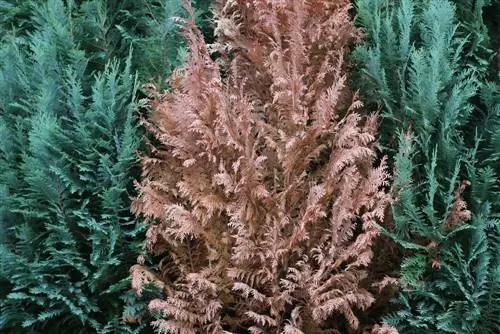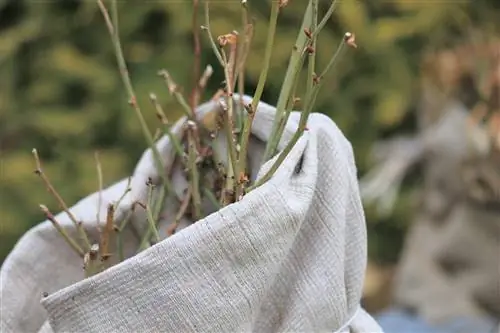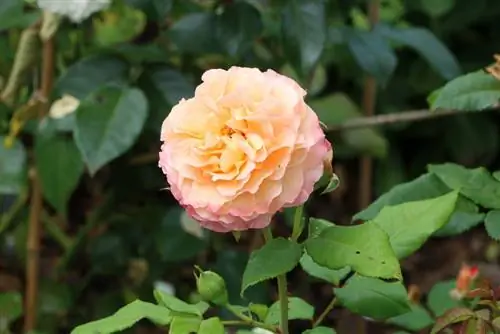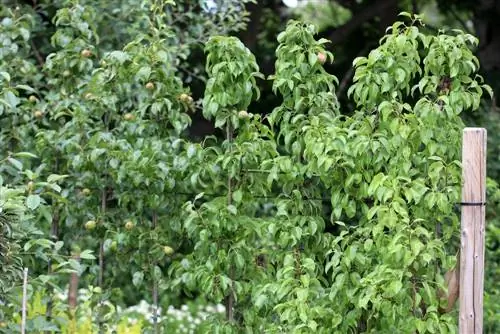- Author admin [email protected].
- Public 2023-12-17 03:39.
- Last modified 2025-01-24 12:45.
If you want to protect garden plants from frost and ice, fleece mats are a reliable solution. Not only that: Fleece and jute felt are ideal not only for the coming winter as frost protection, but also for the summer as sun protection.
Useful uses of jute felt and fleece
The two materials are available online and in every hardware store at affordable prices and can not only be used to cover various sensitive plants, because excess material can be used excellently to beautify flower pots. This means you can give away your own specially grown flowers or bushes, wrapped with fleece or felt around the flower pot. The material is easy to cut, malleable, permeable to moisture and light and has breathable properties, which is particularly good for the plants. The felt or fleece is UV and weather resistant and is 100% biodegradable, which is also worth mentioning in this context.
The fleece or jute felt material sold in stores as mats is used to lay the garden floor to protect the roots from excessive sunlight or frost. Flower pots can be wrapped with these materials to protect the entire pot from frost - and placing the pots on mats made of fleece also protects the plants. Roses, bushes and trees that are sensitive to the weather should be covered with a hat or hood made of fleece. This may look funny, but it protects the plants immensely.
In the colors beige to dark green and with differentiated decors, the fleece hoods adapt wonderfully to the surroundings and the various versions, which are even available with a zipper, are the ideal winter protection for plants of all sizes. Tree trunks wrapped with jute felt, e.g. B. are protected with little effort and the fun, colorful decors of the different versions make your garden shine colorfully even in winter.
Internal winter protection and relocation for certain plants
The plants can not only be protected externally with fleece or jute felt, the internal winter protection, which is just as important, begins in midsummer. Incorrect fertilization measures can make your plants, trees and shrubs less winter-resistant. Nitrogen fertilizer should no longer be used after July 15th of each year, because fertilizing with nitrogen too late impairs the maturity of the wood and therefore makes the shoots of plants and trees more susceptible to frost damage. Young perennials, shoots and trees are grateful for external winter protection in the first few years. Nevertheless, there are plants for which winter protection inside and out is not enough. So e.g. E.g. the geranium, which is a perennial plant but still not hardy:
- In late autumn, you should cut off all the shoots of the plant, shorten half of the entire plant and break out the flowers.
- Then the geranium should overwinter in a cool place, around 5°C and brightly.
- Dahlia and gladiolus tubers must be dug out of the ground and allowed to dry a little.
- Then they should overwinter in a frost-free place, preferably in the cellar, but keep them moist.
Mediterranean plants such as. B. Oleander, most types of palm trees, exotic woods or bougainvillea can be stored frost-free inside the house over the winter.
Winter protection is more than just frost protection
Evergreen plants need a lot of light and water even in winter, so the location of the plants must be chosen carefully and, if necessary, watered in winter. All other shrubs and trees are best kept in the shade as frost protection, because the slightest amount of sunlight leaves the upper shoots frost-free, so water can evaporate above them and the frost in the ground does not allow the roots to absorb new water. There is therefore a risk of drying out even in winter. Proper protection for all kinds of plants in winter not only protects them from frost, but also protects them from drying out.
Avoid winter pests

If you have plants in their winter quarters in the basement or attic, you should check them for pests from time to time. The most common winter pests are spider mites, aphids and any type of scale insect, which likes to be on the underside of the leaves and on the stems. Early detection simplifies the removal of pests. Mechanical removal and plucking is only possible in the early stages. If the infestation is already advanced, you can resort to commercial remedies or use a mixture of water, denatured alcohol and soft soap. To ensure that a plant is not infested in the first place, the location must be chosen carefully and individually, as the infestation is often in the wrong location.
The right tools and materials for the job
For proper winter protection you need materials and tools as follows:
- Jute felt or fleece for cutting to size for potted or container plants
- Jute bags or mats for shrubs, covering and tree trunks
- Peat, bark mulch or pine branches to cover larger areas
- stable floral wire for attaching the jute mats
- Garden fork for picking out the plant tubers
- Gardening Gloves
- Garden shears for trimming plants and bushes, possibly hedge trimmers or loppers
- Rake the leaves
- Flower trowel or planting shovel
- Spade and rake for soil cultivation
- Pest control spray bottle
What you should know about winter protection fleece soon
Autumn after autumn, the question arises for the hobby gardener as to how the plants in the home garden can best be protected against the winter climate so that they can enjoy blooming shrubs, flowers and lively greenery again in the coming year can.
Protective covers made of fleece or jute felt offer very good protection for the trees and potted plants in the expected cold temperatures (and excessive sunlight). They are also becoming increasingly popular when used in flower boxes and beds. Your advantages:
- They are easy to handle (i.e. they are quite easy to cut and shape, for example).
- They are perfectly insulating and also made of a pleasantly soft and light material.
- The light and moisture permeable nature as well as the breathable properties also speak for themselves.
- Another important point in this context is that they are 100% biodegradable and UV and weather resistant.
Little tip - to talk again about the versatility of jute felt: Not only is it increasingly being used as a mulch mat, but jute felt is also a great material when it comes to decorating the home or in the winter garden. It can also be used to wrap gifts in a visually appealing way. Decoratively wrap flower pots.
Ground and garden fleeces and jute felt are available from various online shops as well as local specialist retailers or hardware stores at very affordable prices - so a good and useful matter in every respect!






